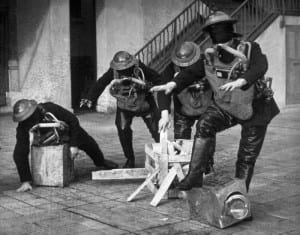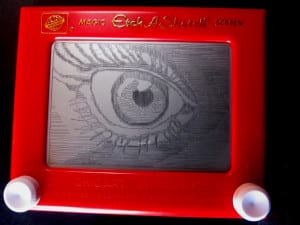
When I talk with first responders about situational awareness and what it takes to develop and maintain it, the program participants often use terms such as: “It’s important to pay attention.” Or, “You have to keep your head on a swivel.” Or, “It helps to look up, down and all around.” All of this is true. But if you were blind to what was happening around you, doing all of that great advice would be worthless.
Blind responders
 It seems odd that I would even suggest the notion that responders can be blind to the things that are happening right in front of them. However, as bizarre as that sounds, it is indeed a fact.
It seems odd that I would even suggest the notion that responders can be blind to the things that are happening right in front of them. However, as bizarre as that sounds, it is indeed a fact.
You can be looking right at something and not see it. [tweet this]
Well, technically, for so long as your eyes are open and the nerves are functioning properly, you are “seeing” what is happening right in front of you.
But simply because you are “seeing” something does not mean you UNDERSTAND what you are seeing.
There is a very distinct difference between seeing something and understanding its meaning. [tweet this]
This not only true of visual inputs, it is also true of audible inputs. You can hear things you don’t understand. But that’s a topic for another day.
Understanding
Understanding the meaning of visual inputs is the second component of situational awareness development (following the first component – perception – The gathering of the visual inputs by the eyes). The processing of visual clues and cues into meaning, understandable information is a very complex process.
 To simplify the process, I use a common household toy to explain how visual inputs get turned into understanding – an Etch-A-Sketch. As visual inputs come into the eyes they get turned into electrical impulses and those impulses are send down the optic nerve to the visual processor. There, the impulses are assembled like a puzzle to form a picture. Once the picture is complete, you “see” the picture using your mind’s eye.
To simplify the process, I use a common household toy to explain how visual inputs get turned into understanding – an Etch-A-Sketch. As visual inputs come into the eyes they get turned into electrical impulses and those impulses are send down the optic nerve to the visual processor. There, the impulses are assembled like a puzzle to form a picture. Once the picture is complete, you “see” the picture using your mind’s eye.
If the picture does not get drawn on your Etch-A-Sketch, there will be on understanding. Thus, you will not understand the meaning of the visual inputs gathered by your eyes.
Mission-Focused
When you are mission focused, it means your mission is on your mind. Stated another way, your mission is on your Etch-A-Sketch. This means your Etch-A-Sketch is pulling double duty. It is sketching all your sensory inputs (sight, sound, smell, taste and feel). At the same time it is sketching what ever else is on your mind. In this case, thoughts about the mission.
When the mission focus is strong, those images on the mind can consume your thoughts. [tweet this]
In other words, the mission focus is what’s on your Etch-A-Sketch. If that happens, there may be no space to draw the incoming visual images. No drawing = no understanding. No understanding = blind to what is happening right before your very eyes.
Chief Gasaway’s Advice
 Being mission focused is a desired trait of a high-functioning team. [tweet this]
Being mission focused is a desired trait of a high-functioning team. [tweet this]
However, it is important to keep in mind that a deep focus and commitment to the mission can cause important – sometimes even life saving – clues and cues to not get processed.
Spend some time watching videos of fire incidents and you will see mission focused blindness. You’ll know it when you see crewmembers doing things that are extremely high risk without a seemingly commensurate benefit. They are all-in on the mission and it appears as though they’re not going to let the facts of the situation get in the way of their attempt to accomplish the mission.
There are times when the mission cannot be accomplished because the conditions are not right. [tweet this]
We cannot save every life and we cannot save every building. To avoid the barrage of hate mail that is likely to fill my inbox for suggesting there are times when aggressive, offensive, interior tactics are not appropriate, let me say that I am a bit advocate for aggressive firefighting. Put the fire out and a lot of the problems go away.
All I’m saying is that when you get completely invested on your mission and your mind is on nothing else but mission accomplishment, you can be blind to important clues and cues that can indicate your mission is going to fail.
Action items
 1. Discuss a time when you were all-in on a mission and so focused on mission accomplishment that you missed seeing important incident scene indicators of danger.
1. Discuss a time when you were all-in on a mission and so focused on mission accomplishment that you missed seeing important incident scene indicators of danger.
2. Discuss strategies for how to unlock from the mission focus so you can comprehend the meaning of the critical incident scene indicators of danger.
3. Discuss how your team can avoid missing important indicators while, at the same time, keeping your mission top of mind.
4. Discuss and list incident scene indicators that might change the mission.
_____________________________________________________
If you are interested in taking your understanding of situational awareness and high-risk decision making to a higher level, check out the Situational Awareness Matters Online Academy.
CLICK HERE for details, enrollment options and pricing.
__________________________________
Share your comments on this article in the “Leave a Reply” box below. If you want to send me incident pictures, videos or have an idea you’d like me to research and write about, contact me. I really enjoy getting feedback and supportive messages from fellow first responders. It gives me the energy to work harder for you.
Thanks,

Email: Support@RichGasaway.com
Phone: 612-548-4424
Facebook Fan Page: www.facebook.com/SAMatters
Twitter: @SAMatters
LinkedIn: Rich Gasaway
YouTube: SAMattersTV
iTunes: SAMatters Radio

